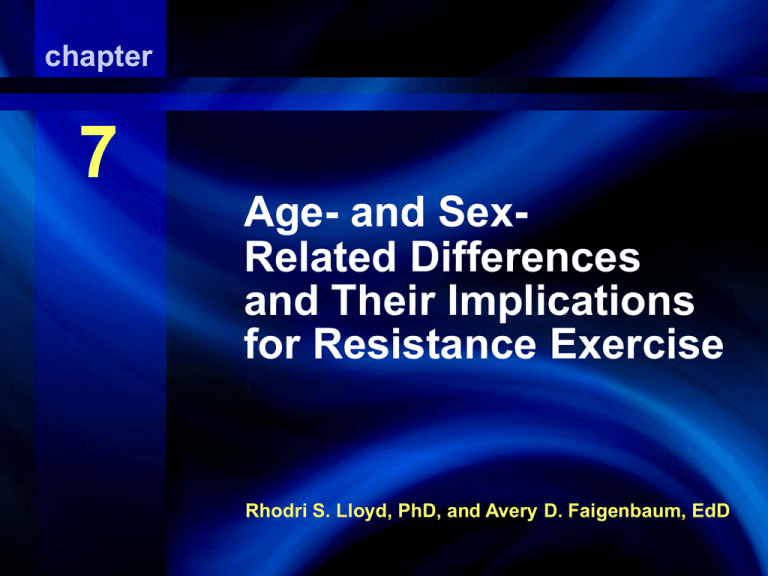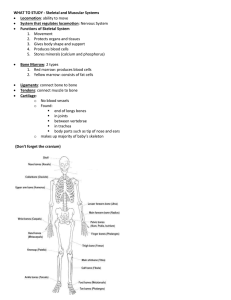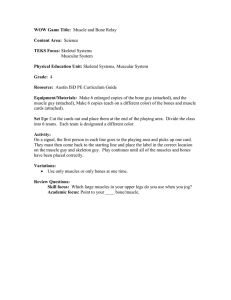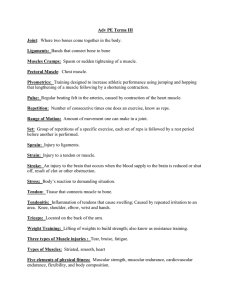7 Age- and Sex- Related Differences and Their Implications
advertisement

Ageand Sex-Related Differences and chapter Their Implications for Resistance Exercise 7 Age- and SexRelated Differences and Their Implications for Resistance Exercise Rhodri S. Lloyd, PhD, and Avery D. Faigenbaum, EdD Chapter Objectives • Evaluate evidence regarding the safety, effectiveness, and importance of resistance exercise for children • Discuss sex-related differences in muscular function and their implications for females (continued) Chapter Objectives (continued) • Describe effects of aging on musculoskeletal health and comment on the trainability of older adults • Explain why adaptations to resistance exercise can vary greatly among these three distinct populations Children • With the growing interest in youth resistance training, it is important for strength and conditioning professionals to understand the fundamental principles of growth, maturation, and development. (continued) Children (continued) • The growing child – Chronological age versus biological age • Puberty refers to a period of time in which secondary sex characteristics develop and a child is transformed into a young adult. • During puberty, changes also occur in body composition and the performance of physical skills. • Children do not grow at a constant rate, and there are substantial interindividual differences in physical development at any given chronological age. (continued) Children (continued) • The growing child – Muscle and bone growth • Muscle mass steadily increases throughout the developing years. • During puberty, increases in testosterone production in boys result in a marked increase in muscle mass, whereas in girls an increase in estrogen production causes increased body fat deposition, breast development, and widening of the hips. • When the epiphyseal plate becomes completely ossified, the long bones stop growing. (continued) Children (continued) • Figure 7.1 (next slide) – Bone formation, which takes place as a result of growth and development Figure 7.1 Key Point • Growth cartilage in children is located at the epiphyseal plate, the joint surface, and the apophyseal insertions. Damage to the growth cartilage may impair the growth and development of the affected bone. This risk can be reduced with appropriate exercise technique, sensible progression, and instruction by qualified strength and conditioning professionals. Children • The growing child – Developmental changes in muscular strength • In boys, peak gains in strength typically occur about 1.2 years after peak height velocity and 0.8 years after peak weight velocity. • In girls, peak gains in strength also typically occur after peak height velocity, although there is more individual variation in the relationship of strength to height and body weight. • On average, peak strength is usually attained by age 20 in untrained women and between the ages of 20 and 30 in untrained men. (continued) Children (continued) • Youth resistance training – Clinicians, coaches, and exercise scientists now agree that resistance exercise can be a safe and effective method of conditioning for children. (continued) Children (continued) • Youth resistance training – Responsiveness to resistance training • Strength gains of roughly 30% to 40% are typically observed in untrained preadolescent children following short-term (8-20 week) resistance training programs. • Data suggest that training-induced strength gains in children are impermanent and tend to return to untrained control group values during the detraining period. Key Point • Preadolescent boys and girls can significantly improve their strength above and beyond growth and maturation with resistance training. Neurological factors, as opposed to hypertrophic factors, are primarily responsible for these gains. Development of Muscular Strength • Figure 7.2 (next slide) – Theoretical interactive model for the integration of developmental factors related to the potential for muscular strength adaptations and performance Figure 7.2 Children • Youth resistance training – Potential benefits • Participation in a youth resistance training program can influence many health- and fitness-related measures. – Potential risks and concerns • Appropriately prescribed youth resistance training programs are relatively safe. – Program design considerations for children • Consider quality of instruction and rate of progression. • Focus on skill improvement, personal successes, and having fun. (continued) Children (continued) • How can we reduce the risk of overuse injuries in youth? – Before sport participation, young athletes should be evaluated by a sports medicine physician. – Parents should be educated about the benefits and risks of competitive sports. – Parents should understand the importance of preparatory conditioning. – Children and adolescents should be encouraged to participate in year-round physical activity. (continued) Children (continued) • How can we reduce the risk of overuse injuries in youth? – Youth coaches should implement well-planned recovery strategies. – The nutritional status of young athletes should be monitored. – Youth sport coaches should participate in educational programs. – Boys and girls should be encouraged to participate in a variety of sports and activities. (continued) Children (continued) • Program design considerations for children – Each child should understand the benefits and risks associated with resistance training. – Competent and caring fitness professionals should supervise training sessions. – The exercise environment should be safe and free of hazards. (continued) Children (continued) • Program design considerations for children – All equipment should be in good repair and properly sized to fit each child. – Dynamic warm-up exercises should be performed before resistance training. (continued) Children (continued) • Youth resistance training guidelines – Static stretching exercises should be performed after resistance training. – Carefully monitor each child’s tolerance to the exercise stress. – Begin with light loads. (continued) Children (continued) • Youth resistance training guidelines – Increase the resistance gradually (e.g., 5% to 10%) as strength improves. – Depending on needs and goals, one to three sets of 6 to 15 repetitions on a variety of exercises can be performed. – Advanced multijoint exercises may be incorporated into the program if appropriate loads are used and the focus remains on proper form. (continued) Children (continued) • Youth resistance training guidelines – Two or three nonconsecutive training sessions per week are recommended. – Adult spotters should be nearby to actively assist the child. – The resistance training program should be systematically varied throughout the year. Female Athletes • Sex differences – Body size and composition • Before puberty there are essentially no differences in height, weight, and body size between boys and girls. • Adult women tend to have more body fat and less muscle and bone than adult males. • Women tend to be lighter in total body weight than men. (continued) Female Athletes (continued) • Sex differences – Strength and power output • In terms of absolute strength, women generally have about two-thirds the strength of men. • If comparisons are made relative to fat-free mass or muscle cross-sectional area, differences in strength between men and women tend to disappear. Key Point • In terms of absolute strength, women are generally weaker than men because of their lower quantity of muscle. Relative to muscle cross-sectional area, differences in strength are reduced between the sexes, which indicates that muscle quality is not sex specific. Female Athletes • Resistance training for female athletes – Women can increase their strength at the same rate as men or faster. – Female athlete triad • Interrelationships between energy availability, menstrual function, and bone mineral density • Caused by high training volumes or intensities with inadequate dietary intake • Increases the risk for osteoporosis and amenorrhea (the absence of a menstrual cycle for more than three months) (continued) Female Athletes (continued) • Program design considerations for women – Upper body strength development • Women tend to have less upper body strength than men, and adding one or two upper body exercises or additional sets may be beneficial for women. • The high caloric cost of performing large muscle mass, multijoint, upper body lifts may aid in maintaining a healthy body composition. (continued) Female Athletes (continued) • Program design considerations for women – Anterior cruciate ligament injury • Female athletes are up to six times more likely to incur an ACL injury than male players. • Joint laxity, ligament size, and neuromuscular deficiency leading to abnormal biomechanics may all be contributing factors. • Strength and conditioning professionals should ensure that females learn, and can repeatedly demonstrate, correct movement mechanics within a variety of environments. Older Adults • Age-related changes in musculoskeletal health – Loss of bone and muscle with age increases the risk for falls, hip fractures, and long-term disability. – Bones become fragile with age because of a decrease in bone mineral content that causes an increase in bone porosity. – After age 30 there is a decrease in the crosssectional areas of individual muscles, along with a decrease in muscle density and an increase in intramuscular fat. Key Terms • osteopenia: A bone mineral density between −1 and −2.5 standard deviations (SD) of the young adult mean. • osteoporosis: A bone mineral density below −2.5 SD of the young adult mean. Key Point • Advancing age is associated with a loss of muscle mass, which is largely attributable to physical inactivity. A direct result of the reduction in muscle mass is a loss of muscular strength and power. Older Adults • Age-related changes in neuromotor function – Seniors are at increased risk of falling. Factors include decreased muscle strength and power, decreased reaction time, and impaired balance and postural stability. – Research shows that physical activity interventions can be effective in improving neuromotor function and preventing falls. (continued) Older Adults (continued) • Responsiveness to resistance training in older adults – Seniors who participate in progressive resistance training programs show significant improvements in • • • • Muscular strength and power Muscle mass Bone mineral density Functional capabilities Key Point • Though aging is associated with a number of undesirable changes in body composition, older men and women maintain their ability to make significant improvements in strength and functional ability. Aerobic, resistance, and balance exercise are beneficial for older adults, but only resistance training can increase muscular strength, muscular power, and muscle mass. Older Adults • Responsiveness to resistance training in older adults – Program design considerations • Both aerobic exercise and resistance training are recognized as important components of a well-rounded fitness program for older adults. • Attention should be given to preexisting medical ailments, prior training history, and nutritional status before starting a resistance training program. • Volume and intensity should be altered throughout the year to prevent overtraining and ensure that progress is made. (continued) Older Adults (continued) • What are the safety recommendations for resistance training for seniors? – All participants should be prescreened. – Warm up for 5 to 10 minutes before each exercise session. – Perform static stretching exercises before or after, or both before and after, each resistance training session. – Use a resistance that does not overtax the musculoskeletal system. (continued) Older Adults (continued) • What are the safety recommendations for resistance training for seniors? – Avoid performing the Valsalva maneuver. – Allow 48 to 72 hours of recovery between exercise sessions. – Perform all exercises within a range of motion that is pain free. – Receive exercise instruction from qualified instructors.






